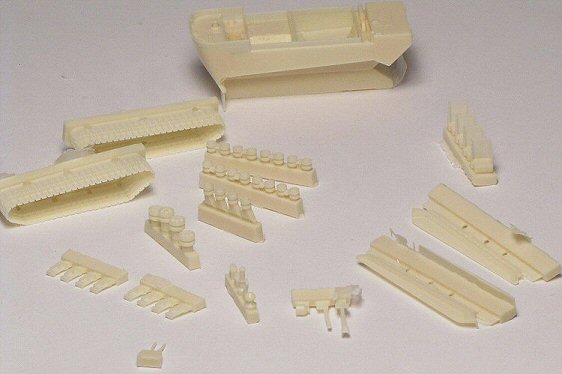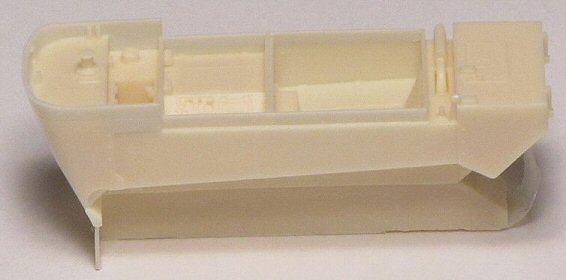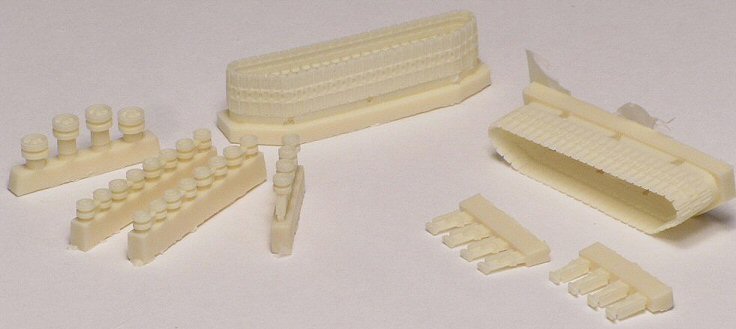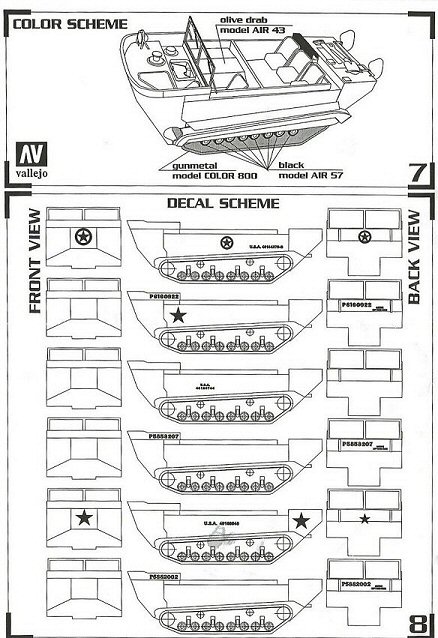Note
that the main parts of this kit are identical to Extratech 7244, although
that kit includes a 30-cal machine gun and pintle mount, as well as
offering some more colourful US and French decal options. Hauler also
offers the original M29 weasel (with blunt bow and stern) as kit 72012,
which is likely the same as Extratech 7243.
Possibly
one of the ugliest US vehicles to see production during the Second
World War, the M29C was a development of the even uglier M29 to make
it fully amphibious. The Weasel was noted for its ability to cross
just about any terrain, from mud to snow to water. This capability
was used extensively by the French in Indochina, where the M29C was
known as the Crabe. |
The
kit comes in a somewhat flimsy end opening box, topped with a colour
photo of an assembled kit. Inside are two zip-close plastic bags,
one containing the main body of the M29C, the other containing 46
detail parts.
A further
bag contains a small photoetched fret, and in my example, two identical
decal sheets.
Instructions
consist of a 2-sided A4 sheet, with a short history in English and
Czech, some small photos of vehicles in service, a parts diagram,
6 assembly steps, the colour scheme, and decal placement guide.
|
 |
|
The resin casting in this kit is probably the best I've seen. The
parts are flawless, with very sharp detail, and no sign of air bubbles
or other defects. The one-piece track assemblies, cast without the
wheels in place, have to be seen to be believed.
My
only concern with the moulding is that the hull has a large casting
block attached to its bottom surface, which will require some careful
work to remove without damaging the delicate detail.
A minor
quibble is that the hull is moulded with the surf guard in the lowered
position. It would have been nice to have this as a separate part,
as French Crabes often had this flipped up and used a seat.
The
kit is also lacking a folding tilt or its frame, again often seen
partly or fully deployed on French examples.
|
 |
|
Perhaps
as a concession to moulding the tracks in one piece, the drive sprocket
has no teeth. This probably won't be obvious if the track guards are
fitted. Technically, each roadwheel should have a groove down its
centre, but this detail would be all but invisible at this scale. |
 |
|
As
is expected from a well-established maker of aftermarket photo etch,
the PE parts are excellent. They provide the windscreen and wipers,
a perforated exhaust shield, two rudders and parts of their linkage,
engine air intake cover and shroud, headlight guard and mount, fire
extinguisher handle and retaining straps for the separately moulded
shovel and axe.
One of
the only details missing is the control cables for the rudder, which
are routed along the left side of the body. |
|
 |
A
really nice touch is the inclusion of a decal sheet. The instructions
show six different schemes, all in overall olive drab, with variations
on the serial number and style/placement/location of the national
star marking. No indication of operating units, locations or dates
is provided.
The colour
scheme instructs the builder to paint the tracks gunmetal. The actual
tracks consisted of rubber bands, with metal plates riveted to the
outside. |
 |
| Conclusion
This
is a really sweet little kit, and it looks like it will go together
well. Though the kit is certainly expensive for its size, it's unlikely
that the Weasel will appear as an injection moulded kit anytime soon.
I would recommend this kit to anyone interested in the subject.
Preview
sample purchased by the author.
This
model can be purchased from

|